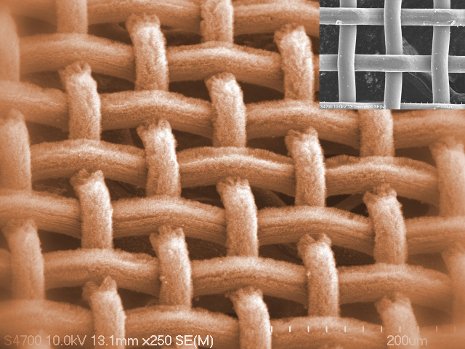Home > Press > Nanotech Filter Separates Oil and Water
 |
| A scanning electron microscopy image of the carbon nanotube-coated filter. For comparison, the inset is bare stainless steel mesh. |
Abstract:
Water and oil may not mix, but, like two boxers nearing the end of the final round, they can get awfully tangled up.
Now, Michigan Technological University scientists Yoke Khin Yap and Jaroslaw Drelich have created a filter that separates the two substances as quickly and cleanly as a ref breaking up a clinch.
Nanotech Filter Separates Oil and Water
Houghton, MI | Posted on April 12th, 2011Their fine, stainless steel mesh is coated with carbon nanotubes about 10 microns across. "They have a super-honeycomb structure that repels water," says Yap, an associate professor of physics. "But they like organic stuff, like oil."
The team poured an emulsion of water and gasoline over the filter to test it. Sure enough, the gas dripped through; all but 20 percent of the water stayed put.
It's not as if you could filter the Gulf of Mexico through the device, Yap cautions. Their prototype is about the size of a quarter. Plus, the water drops can actually clog the spaces between the nanotubes, making it hard for anything to get through. "But the attractive thing is that it's so simple," he says. "It runs by gravitation."
Drelich, an associate professor of materials science and engineering, thinks the filter has real-world potential. "These were just our first set of experiments," he says. "We could supply electricity to it to heat it up, reducing the oil's viscosity evaporating the water. We could also create a vacuum that would suck oil through the filter to the other side. A good engineering design could get rid of clogging problem."
Such technology could help purify oil from Canada's tar sands, which is contaminated by traces of corrosive salt water. Or, it could be used to recover oil from the wastewater of ocean-going vessels. It might even be able to scrub the oil inside your car's engine.
"Our design would be completely novel, because it relies on nanotechnology, and it could be competitive," says Drelich.
Their work was published in the Feb. 2 edition of the journal Carbon and is funded by the National Science Foundation.
####
About Michigan Technological University
Michigan Technological University (www.mtu.edu) is a leading public research university developing new technologies and preparing students to create the future for a prosperous and sustainable world. Michigan Tech offers more than 130 undergraduate and graduate degree programs in engineering; forest resources; computing; technology; business; economics; natural, physical and environmental sciences; arts; humanities; and social sciences.
For more information, please click here
Contacts:
Marcia Goodrich
906-487-2343
Administration Building G14
Copyright © Michigan Technological University
If you have a comment, please Contact us.Issuers of news releases, not 7th Wave, Inc. or Nanotechnology Now, are solely responsible for the accuracy of the content.
| Related News Press |
News and information
![]() Simulating magnetization in a Heisenberg quantum spin chain April 5th, 2024
Simulating magnetization in a Heisenberg quantum spin chain April 5th, 2024
![]() NRL charters Navy’s quantum inertial navigation path to reduce drift April 5th, 2024
NRL charters Navy’s quantum inertial navigation path to reduce drift April 5th, 2024
![]() Discovery points path to flash-like memory for storing qubits: Rice find could hasten development of nonvolatile quantum memory April 5th, 2024
Discovery points path to flash-like memory for storing qubits: Rice find could hasten development of nonvolatile quantum memory April 5th, 2024
Govt.-Legislation/Regulation/Funding/Policy
![]() NRL charters Navy’s quantum inertial navigation path to reduce drift April 5th, 2024
NRL charters Navy’s quantum inertial navigation path to reduce drift April 5th, 2024
![]() Discovery points path to flash-like memory for storing qubits: Rice find could hasten development of nonvolatile quantum memory April 5th, 2024
Discovery points path to flash-like memory for storing qubits: Rice find could hasten development of nonvolatile quantum memory April 5th, 2024
![]() Chemical reactions can scramble quantum information as well as black holes April 5th, 2024
Chemical reactions can scramble quantum information as well as black holes April 5th, 2024
Nanotubes/Buckyballs/Fullerenes/Nanorods/Nanostrings
![]() Tests find no free-standing nanotubes released from tire tread wear September 8th, 2023
Tests find no free-standing nanotubes released from tire tread wear September 8th, 2023
![]() Detection of bacteria and viruses with fluorescent nanotubes July 21st, 2023
Detection of bacteria and viruses with fluorescent nanotubes July 21st, 2023
Discoveries
![]() Chemical reactions can scramble quantum information as well as black holes April 5th, 2024
Chemical reactions can scramble quantum information as well as black holes April 5th, 2024
![]() New micromaterial releases nanoparticles that selectively destroy cancer cells April 5th, 2024
New micromaterial releases nanoparticles that selectively destroy cancer cells April 5th, 2024
![]() Utilizing palladium for addressing contact issues of buried oxide thin film transistors April 5th, 2024
Utilizing palladium for addressing contact issues of buried oxide thin film transistors April 5th, 2024
Announcements
![]() NRL charters Navy’s quantum inertial navigation path to reduce drift April 5th, 2024
NRL charters Navy’s quantum inertial navigation path to reduce drift April 5th, 2024
![]() Discovery points path to flash-like memory for storing qubits: Rice find could hasten development of nonvolatile quantum memory April 5th, 2024
Discovery points path to flash-like memory for storing qubits: Rice find could hasten development of nonvolatile quantum memory April 5th, 2024
Water
![]() Taking salt out of the water equation October 7th, 2022
Taking salt out of the water equation October 7th, 2022
|
|
||
|
|
||
| The latest news from around the world, FREE | ||
|
|
||
|
|
||
| Premium Products | ||
|
|
||
|
Only the news you want to read!
Learn More |
||
|
|
||
|
Full-service, expert consulting
Learn More |
||
|
|
||








